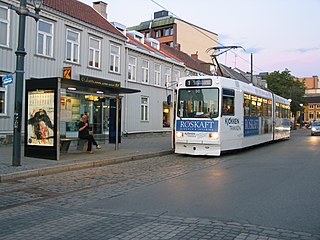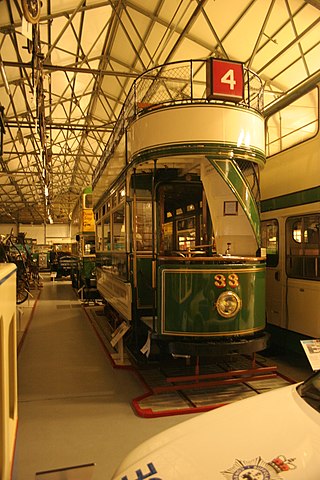
Hong Kong Tramways (HKT) is a 3 ft 6 in narrow-gauge tram system in Hong Kong. Owned and operated by RATP Dev, the tramway runs on Hong Kong Island between Kennedy Town and Shau Kei Wan, with a branch circulating through Happy Valley.

The Peak Tram is a funicular railway in Hong Kong, which carries both tourists and residents to the upper levels of Hong Kong Island. Running from Garden Road Admiralty to Victoria Peak via the Mid-Levels, it provides the most direct route and offers good views over the harbour and skyscrapers of Hong Kong. Operated since 1888, it was the first funicular railway in Asia.

Melbourne tram route 57 is operated by Yarra Trams on the Melbourne tram network from West Maribyrnong to Flinders Street station. The 11.6 kilometre route is operated out of Essendon depot with Z class trams.

The Sydney tramway network served the inner suburbs of Sydney, Australia, from 1879 until 1961. In its heyday, it was the largest in Australia, the second largest in the Commonwealth of Nations, and one of the largest in the world. The network was heavily worked, with about 1,600 cars in service at any one time at its peak during the 1930s . Patronage peaked in 1945 at 405 million passenger journeys. Its maximum street trackage totalled 291 km in 1923.

Sheffield Tramway was an extensive tramway network serving the English city of Sheffield and its suburbs.

The Gråkallen Line is an 8.8-kilometre (5.5 mi) suburban tram line located in Trondheim, Norway. As the only remaining part of the Trondheim Tramway, it runs from the city centre at St. Olav's Gate, via the suburban area Byåsen to Lian. It is designated Line 9, and is served by six Class 8 articulated trams. After the closure of the Arkhangelsk tramway in 2004, it became the world's northernmost tramway system.

Seestraße is a station in the Wedding district of Berlin which serves the U6 and is operated by the BVG. It lies at the busy intersection of Müllerstraße and Seestraße, which are two of Wedding's principal shopping streets and thoroughfares.

The Trondheim Tramway in Trondheim, Norway, is the world's most northerly tramway system, following the closure and dismantling of the Arkhangelsk tramways in Russia. It consists of one 8.8-km-long line, the Gråkallen Line, running from St. Olav's Gate in the city centre through Byåsen to Lian Station in Bymarka.

Munkvoll Station is a tram station on Gråkallbanen. It is part of the Trondheim Tramway in Trondheim, Norway. The station was built in 1924 as the terminus for the tramway. In addition to housing the Trondheim Tramway Museum, it features the offices and depot for the tram operator, Boreal Bane. The station also features one of the double track stretches on the line, where trams can pass.

The Singsaker Line was a branch of the Trondheim Tramway which ran from Øya and Elgeseter to the neighborhoods of Singsaker, parts of Tyholt and Rosenborg in Trondheim, Norway. The line branched off from the Elgeseter Line at the Student Society. It was double track until Tyholtveien, after which it ran through a loop through Rosenborg. It was served by Line 3, which continued through the city center to Trondheim Central Station.

The Elgeseter Line was a tramway line in Trondheim Tramway between Trondheim Torg and Elgeseter. The tram line was built in 1913, expanded in 1923 and abandoned in 1983. It was used by Line 2 operated by Trondheim Sporvei, later Trondheim Trafikkselskap, though part of the line was used by Singsaker Line.

The Lade Line was a tramway between Munkegata and Lade in Trondheim, Norway. The first part of the line was opened in 1901, but not expanded to Lade until 1958. The line was operated by Trondheim Sporvei and Trondheim Trafikkselskap until it was abandoned in 1988.
Elgeseter is a neighborhood in the city of Trondheim in Trøndelag county, Norway. It is located in the western part of the borough of Lerkendal. It is south and east of the river Nidelva, south of the neighborhoods of Midtbyen and Øya, west of Singsaker and north of Nardo. The name comes from Helgeseter, the name of Helgeseter Priory, an Augustinian abbey located at Elgeseter during the Middle Ages.

Warrington Corporation Tramways was the owner and operator of an electric tramway system in the early 20th century serving the town of Warrington, at the time a county borough of Lancashire, England.

The Dalsenget fire was a disaster where the Dalsenget Depot of Trondheim Sporvei burnt down, destroying almost all of the modern tram fleet. 26 trams, 16 trailers and one working tram were destroyed, and three cleaners lost their lives. It was, at the time, the largest fire in Trondheim, Norway, after World War II.

The Trondheim Tramway controversy regards the political discussion of whether Trondheim, Norway, should have a tramway.

Lowestoft Corporation Tramways was the operator of the electric tramway system that served Lowestoft from 22 July 1903 until 8 May 1931.

Alsancak railway station is one of the two main railway terminals in İzmir and is the second-oldest railway station in Turkey, after Kemer, being completed in 1858. The station is the main hub for İZBAN trains, and is the terminus for both lines.

Ipswich Corporation Tramways was an electric tramway system that served the town of Ipswich in Suffolk from 23 November 1903 until 26 July 1926.

The Kolkata Tram System, is a LRT system that serves Kolkata, the capital city of the Indian state of West Bengal, operated by West Bengal Transport Corporation (WBTC) after Calcutta Tramways Company (CTC) was merged with WBTC, is the oldest tram network operating in India, and oldest operating tramway in Asia. Being electrified in 1902, it is the second oldest electric tramway in India. It is the only operating tram network of India at present.


















